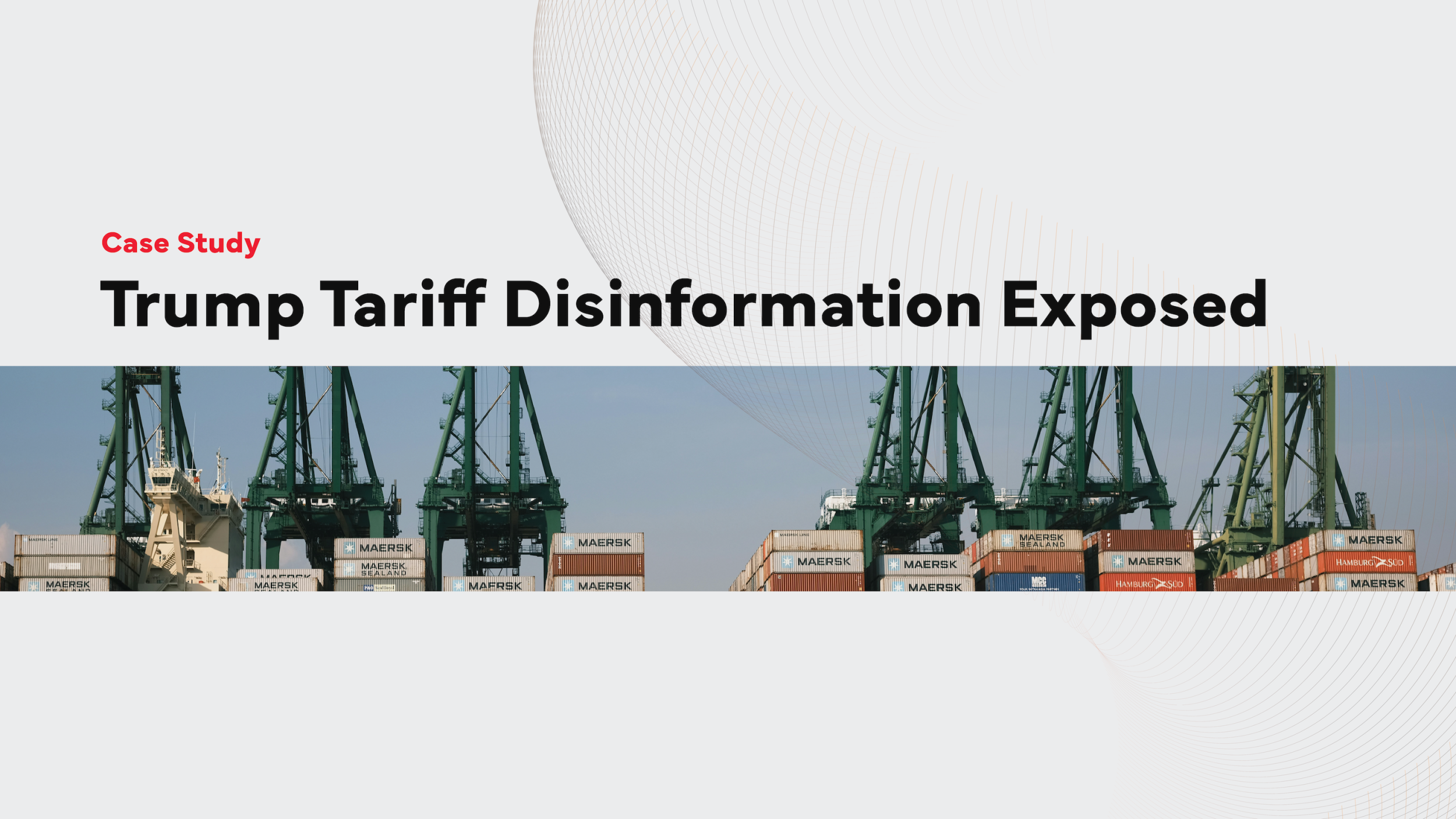Revealing Manipulation with Koat and Mitigating Market Chaos Through Disinformation Detection
The recent incident involving fake news about a potential 90-day pause on global tariffs by President Donald Trump exposed the vulnerabilities of the financial market to disinformation. The false headline, which gained traction on social media platforms such as X (formerly Twitter), triggered a dramatic series of events. Within minutes of the post, the S&P 500 surged nearly 6%, driven by optimism stemming from the fabricated report. However, once the news was debunked, the market quickly reversed its gains, resulting in volatility that left traders and investors scrambling to adapt. Major news outlets unintentionally amplified the false narrative, further intensifying its impact.
This event illustrates how quickly disinformation can ripple through financial systems, influencing public sentiment and market behavior in real-time. It also highlights the challenges in verifying the authenticity of breaking news, especially when trading algorithms and financial institutions react at unprecedented speeds.
Tools like Koat could play a critical role in mitigating such risks. By leveraging real-time monitoring, fake account detection, and advanced sentiment analysis across text, images, and even memes, Koat could have identified the disinformation as it spread. Its capability to detect abnormalities and deliver contextual summaries from a broad spectrum of media sources—including traditional, social, and fringe—would provide a robust defense against such incidents. Koat’s technologies not only enhance the accuracy of information but also reduce response times, allowing markets to respond based on verified facts rather than misleading headlines.
Disinformation’s Impact on Financial Market Stability
What makes this situation particularly concerning is how the false information propagated across multiple channels. Social media accounts with large followings, like Walter Bloomberg, amplified the claim, citing questionable sources or misinterpreted data. Financial institutions and trading desks, often reliant on the speed of information rather than its verification, reacted almost instantaneously, adding to the market chaos. Moreover, the story was picked up and broadcast by established news outlets, further legitimizing the disinformation and contributing to market volatility.
Detecting and mitigating such disinformation in real-time presents substantial challenges. Social media platforms operate at lightning speed, and false headlines can spread globally within seconds. The decentralized nature of content creation makes it difficult to trace the original source, and the pressure on financial institutions and news organizations to report quickly exacerbates the problem. Once disinformation is introduced into the ecosystem, it becomes increasingly difficult to control, as algorithms, bots, and human behavior amplify its reach. Without robust systems to monitor and authenticate information as it emerges, markets and public sentiment remain vulnerable to manipulation, creating unnecessary risk and instability. This incident underscores the urgent need for technological solutions capable of addressing the complexities of disinformation in real-time.
The Cost of Disinformation
Market manipulation through disinformation isn’t new, but its scale and speed have been magnified by digital platforms. Here’s what was at stake in this event:
- Billions in asset value were temporarily inflated and then wiped out.
- Retail investors suffered whiplash losses as algorithmic trading systems reacted to the volatility.
- Institutional credibility was damaged as major news channels failed to verify sources.
- Public trust in financial markets was undermined.
In such high-stakes environments, real-time detection, analysis, and mitigation of disinformation is not just a nice-to-have—it’s a necessity. That’s where Koat comes in.
Leveraging Koat to Combat Market Disinformation
Koat’s advanced suite of capabilities offers critical tools to detect and mitigate disinformation in real-time, particularly in scenarios like the recent fake news incident impacting the US stock market. By combining real-time fake account detection, sentiment analysis, contextual summaries, and whole web listening, Koat provides a comprehensive solution to identify and counter the rapid spread of false information.
In this case, the false headline originated on social media and quickly influenced public sentiment and market behavior. Using its real-time fake account detection capability, Koat could have identified suspicious accounts, such as those posing as credible sources like Walter Bloomberg. This feature scrutinizes behavioral patterns, account histories, and network connections to flag entities that show signs of being inauthentic or spreading unreliable content. For example, if Koat had detected inconsistencies in the account’s posting patterns or its engagement with unverified sources, it could have raised immediate alerts, prompting further review.
Koat’s real-time sentiment analysis would have been crucial in identifying abnormal market-related chatter across platforms. By analyzing the tone and emotional drivers in the content, Koat could have detected the sudden surge in optimistic sentiment tied to the fake tariff pause headline. This feature goes beyond simple keyword tracking, offering a nuanced understanding of the collective emotional response, which would have provided an early warning signal of potential market manipulation.
Through whole web listening, Koat monitors a vast array of data sources, including traditional media, social platforms, and fringe outlets. This capability enables a full-spectrum view of how disinformation propagates across different channels. In the case of the fake headline, Koat could have mapped its origin and tracked its amplification as it moved from one account to another, eventually making its way to mainstream media outlets. By identifying the speed and scale of the spread, Koat would have allowed stakeholders to isolate the story and assess its authenticity before it gained further traction.
Koat’s ability to provide contextual summaries in real-time would have delivered concise, actionable insights to newsrooms, trading desks, and decision-makers. Instead of relying on fragmented information, stakeholders could have accessed a clear analysis of the disinformation, helping them make informed decisions and issue timely corrections. Together, these capabilities position Koat as an indispensable tool for mitigating the risks associated with disinformation in high-stakes scenarios.
Mitigating Market Chaos Through Koat’s Solutions
Koat could have significantly reduced the impact of the fake news incident by utilizing its advanced capabilities to detect, analyze, and counteract the disinformation in real-time. The first step would have been identifying the initial source of the fabricated headline through Koat’s whole web listening functionality. By monitoring a vast network of thousands of data sources—including social platforms like X, Reddit, and fringe media outlets—Koat would have flagged the posts from the earliest known account to publish the false claim. Koat’s ability to track data flows across platforms would have enabled it to trace the spread of the headline to influential accounts like Walter Bloomberg, identifying how it gained traction.
Real-time fake account detection would have played a critical role in assessing the credibility of the accounts amplifying the claim. By analyzing patterns in activity, account creation history, and follower engagement, Koat could have flagged accounts exhibiting unusual or inauthentic behavior. For example, if Koat had detected irregularities in those posts or Walter Bloomberg’s posting habits or their reliance on unverified information, these accounts would have been categorized as high-risk and flagged for immediate review.
Simultaneously, Koat’s sentiment analysis would have detected the sudden surge in optimistic chatter related to the fake headline. By evaluating all of this, Koat would have identified an anomaly in the tone and volume of market-related discussions. This data would have been cross-referenced with traditional media reports and trading activity, highlighting discrepancies between sentiment trends and verified news, thereby offering early indicators of manipulation.
Koat’s real-time contextual summaries would have provided decision-makers with actionable insights as the situation unfolded. Financial institutions, trading desks, and news organizations could have received concise reports outlining the spread of the false headline, the accounts involved, and its impact on market sentiment. These summaries would have enabled stakeholders to quickly issue corrections, adjust strategies, and limit further amplification of the disinformation.
Finally, Koat’s ability to continuously monitor and validate breaking news would have served as a safeguard against disinformation. By providing stakeholders with a comprehensive view of the situation, from initial detection to its broader impact, Koat would have empowered them to respond proactively, minimizing volatility and restoring trust in the information ecosystem. This layered approach underscores Koat’s value in maintaining the integrity of high-stakes environments.
Preventing Market Manipulation with Real-Time Intelligence
Koat’s suite of advanced tools could have significantly reduced the impact of the fake news incident by enabling real-time detection, analysis, and response to disinformation. By identifying the origins of the false headline, tracking its spread, and analyzing the abnormal sentiment it generated, Koat would have provided actionable insights to stakeholders before the situation escalated. Its capabilities to flag suspicious accounts, monitor diverse media channels, and deliver clear contextual summaries would have empowered decision-makers to act swiftly, minimizing market disruption and limiting the reach of the disinformation.
The broader implications of using Koat extend beyond mitigating individual incidents. By providing a robust, real-time defense against disinformation, Koat strengthens the integrity of financial markets and protects public trust. Its ability to reduce risks tied to disinformation enhances confidence in the systems that drive global economies, ensuring that decisions are made based on accurate, verified information rather than unverified narratives.


